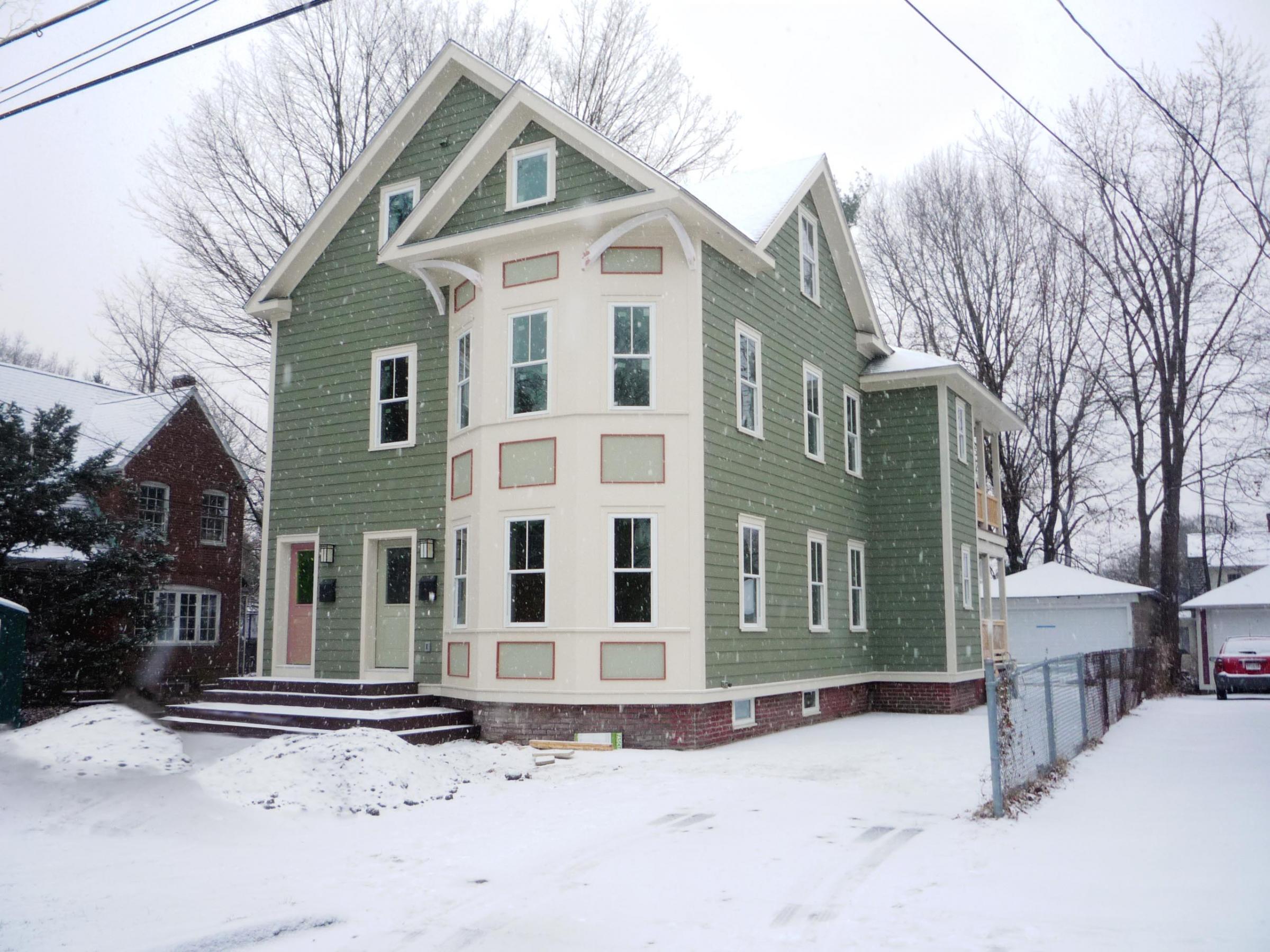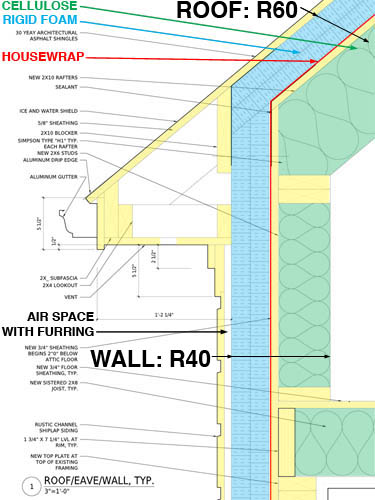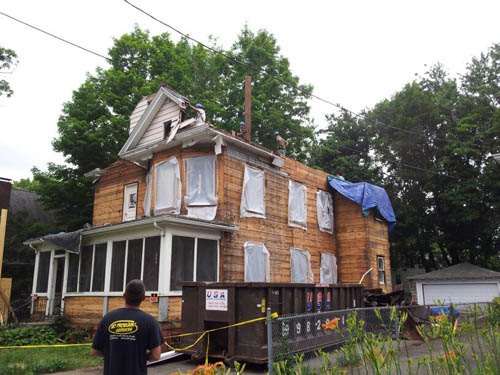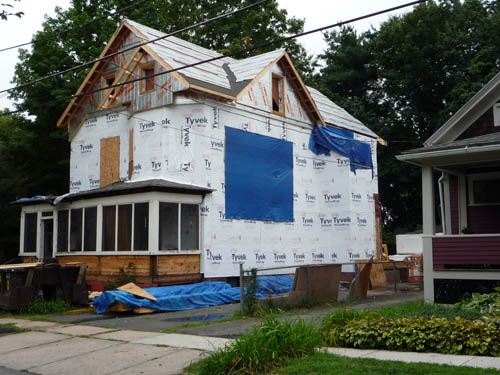Project Subtitle:
Project Description:
The owners, Peter and Rachel Stevens, are also the architects. As they started renovations, it became clear that most of the systems and finishes needed replacing, which made this two-family a perfect candidate for a Deep Energy Retrofit. All the exterior finishes had lived out their lifespan (and the aluminum siding recycles well), so exterior insulation was easy to add. The largest challenge for this job was to preserve some of the interior finishes and detail while replacing the entire shell and all systems. The owners helped with the insulating and air sealing, and ran interim blower-door tests, and they continue to work on interior paint and other small projects. They now enjoy a home that comfortably shelters their new daughter, as well as a family with two small children in the first floor apartment.
This project was funded in part by a grant from National Grid as part of their Deep Energy Retrofit pilot program. The project achieved a bonus for exemplary performance.
This home is Zero Energy Ready. Due to healthy, mature trees on the southern side of the site, photovoltaics are being purchased offsite as part of a community solar program. This offsite array will completely offset all energy used by the Stevens family. Meanwhile, a green energy surcharge is being paid to National Grid. The first floor unit could also pursue these same steps (even as tenants) to achieve Zero Energy for that portion of the house.
Building Type Summary:
Other Awards:
National Grid Deep Energy Retrofit Pilot Program 2013
Address:
Elevation:
Lat. / Long.:
Location Type:
Köppen Climate Type:
Climate Region:
Solar Insolation:
Annual HDD :
Annual CDD:
HDD Base Temp:
CDD Base Temp:
Occupancy Type and Details:
Two-family.
First floor is rented, two bedrooms one bath, one adult and two children, empty during the weekdays.
Second and third floor is owner-occupied, three bedrooms, three baths, two adults and one child, including an office. Owners work from home, so unit is occupied most of the time.
Conditioned Floor Area:
Conditioned Building Volume:
Semiconditioned Floor Area:
Multiple buildings?:
Total number of units in project (all buildings):
Historic?:
Completion date:
Materials:
As a project for ourselves, we felt we could experiment a bit with materials. We used seconds from the mill of a new material, Boral's Truexterior, and milled it to a modern, square shiplap siding. The mill said they would not accept that job again, as the material is very hard to mill, but Boral is now producing siding profiles that do not need to be milled. Our project helped further this application!
We also used a new material for our front steps: Perennial Wood. It has been completely maintenance free and very stable for this high-impact weather location, but the density of the material also makes it quite slippery when wet. We added walk-off mats and grip strips to avoid slipping.
Energy Highlights:
all-electric
superinsulation
high-efficiency heat pumps
ERV to reduce heat loss
EV charges simply from an outdoor outlet
LCA Description:
No.
Annual renewable energy generated:
Electric Utility Company:
Gas Utility Company:
Datasets and Utility Bills sources and reliability:
power company, highly reliable
Electricity amount (imported from grid):
Electricity amount (credited or exported to grid):
Net electricity usage (purchased electricity):
Natural gas amount (purchased energy):
Energy Storage type:
minor thermal mass of building itself
CHP System Description:
none
Subslab assembly:
Given the existing slab, we insulated above the slab. Dimple mat to allow movement of any water, taped. 2" rigid foam (XPS) insulation, taped. Click-together laminate flooring.
Slab edge assembly:
n/a
Foundation wall assembly:
We used foil-faced polyiso on the walls to provide a vapor barrier as well as air sealing and insulation. Two layers offset provided backup.
There were masonry nails in the brick foundation, and rather than risk destroying the brick (with hours of hard work) we decided to use thicker insulation on the first layer.
2" + 1" for a total of 3" foil-faced polyiso
Above grade wall assembly:
The house is balloon framed with actual 2"x4" lumber. Our favorite insulation, dense packed cellulose, was not enough to superinsulate. We used it in the existing framing, and then added 2, 2" foil-faced polyiso layers staggered on the exterior. Furring strips held the siding away for airflow.
Flat attic assembly:
The third floor is tucked up under the roof, with only a short kneewall above the floor deck. A small amount of flat ceiling has a minimum of 24" of loose cellulose, but otherwise the assembly is cathedral.
Cathedral ceiling assembly:
The existing roof was very bowed, in one case slumping 4" just from one end of the dormer to the other. It was not thick enough for superinsulation either, and sistering deeper framing was not a preferred approach by our builders. So we replaced the framing with 2x10s, filled with dense-packed cellulose, and added 2 layers of 2" foil-faced polyiso on top.
Door Area:
Space heating - Manufacturer & Model:
Space heating - capacity:
Space cooling - Manufacturer & Model:
Space cooling - capacity:
Domestic hot water - Manufacturer & Model:
Domestic hot water - capacity:
Domestic hot water - efficiency:
Ventilation - Manufacturer & Model:
Process:
We were gifted a huge resource of design review by Building Science Corporation, through the National Grid DER pilot program. Their advice was very valuable as we navigated this new construction style. And we sought input from other NESEA members, notably Paul Eldrenkamp and Marc Rosenbaum. We worked closely with builders during design to choose buildable approaches to this retrofit. And we worked with manufacturers to find new applications for interesting new products (see envelope description).
Design for Adaptability:
We did not need three baths for our unit, but in discussions with realtors, we found that would be the preferred arrangement for any future residents. It also allows for the unit to be inhabited by more unrelated people, for example as a student rental.
Other Software tools:
National Grid pilot program spreadsheet, which asks pertinent questions about energy efficiency that are often hard to find in manufacturer's literature. A good high standard for specifications.
Outcome of project goals:
The initial building team did not meet the air sealing goals for the project, and indeed was not actively testing for them. The site super was religious about carrying a foam gun around to get each penetration, but the initial air barrier layer was poorly installed and not corrected when it was called out. As framers are asked to do new jobs in this high performance building method, it may be useful to tie their contract to the air barrier goals to ensure each responsible party is on board with the goals.
We borrowed blower doors and did our own testing, and one weekend dropped 500cfm just by caulking some of the framing. (Thanks to Byggmeister for the loan of the door and smoke machine!) And we did a lot more air sealing on the interior, which was expensive, time-consuming, and aesthetically challenging. Ultimately, with the new team, we exceeded our goal by a healthy margin, which was a very exciting reward for all that extra work!
Discrepancies:
The Thermatru doors gave an overall unit rating that met our program requirements, but in order to get this rating, they needed to be "impact rated" which includes more metal framing in the door. Significant thermal bridges result. We have not changed out the doors, but next time we do any work on the house they will be on the list, as the condensation around the windows is considerable. While PHPP is a daunting level of design investment in a project, we all need to learn to think like a Passive House designer at least on a macro level to catch these egregious discrepancies.
Finances Description:
Florence Bank, a local institution, gave us an ample construction loan that allowed us to stretch our budget to achieve the many efficiency requirements of the pilot program. While the National Grid program gave us an enormous grant, and even a bonus for high performance, we are not likely to see energy paybacks in our lifetime. It is hard to separate the work required due to an extended vacancy of the building, and the work specifically targeted to efficiency, not to mention our own design improvements.
Total Cost of Project:
Construction hard cost:
Net Cost of renewable energy systems:
Utility incentives:
60,000 Grant
3,000 Bonus
Advice:
Do the work when it makes sense to do the work. Construction is expensive, but efficiency can be cheap when the timing aligns with related work.
Published References:
Construction Blog
http://maplearch.com/revell/
Special architectural measures:
Our main approach was to superinsulate and air seal as much as possible. We also removed a staircase on the south side of the building to allow more south light into one of the units.
Energy Strategies:
We decided to go all-electric as that allows us to most easily source our fuel sustainably. By eliminating fossil fuels from all of our heating, cooking, and even transportation, we are able to immediately purchase green energy even though we can't put PV right on our roof.
Energy Use and Production Documentation:
Subslab R-value:
Foundation wall R-value:
Above grade wall R-value:
Cathedral ceiling R-value:
Average window U-factor:
Solar Heat Gain Coefficient:
Visible Light Transmittance:
Door U-Factor:
Cost per square foot of Conditioned Space:
Air Changes per hour, ACH50:
Project Photos:





Number of Bathrooms:
Scope Description:
Two-family home. Second floor unit is also used as an architecture office.
Entire building was renovated including basement. Third floor (roof and knee wall) was completely demolished and rebuilt.
Site conditions:
Renewable Energy Sources:
Other Purchased Fuels Description:
no
Summary of enclosure strategy/description:
The 100+ year old framing was strong enough on the walls but not the roof, so we replaced the roof with thick framing for superinsulation and added 4" more insulation to the exterior of all the walls and roof. The siding needed replacing anyway, making an exterior approach easy. We were not up to the task of excavating around the foundation, so we had to move inside for the basement insulation.
Roof Assembly:
see above
Roof R-value:
Window Description:
vinyl, Paradigm, mostly double-hung, a few casement, two awning and 3 fixed in basement, all triple glazed, low-e (surfaces 2 and 5) with argon
8321 Premium Double Hung foamed frame
Door Description:
Thermatru Smooth Star
